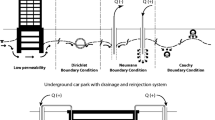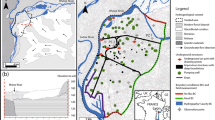Abstract
The quaternary deposit of Shanghai is composed of an alternated multi-aquifer-aquitard system (MAAS) consisting of a sequence of aquitards laid over aquifers one by one. In the MAAS, any drawdown of groundwater head in an aquifer may cause consolidation of the overburden aquitard. When underground structures penetrate those aquifers, groundwater seepage path changes and drawdown occurs at the side characterized by the lower hydraulic potential along the flow direction (hereafter refers as to the lower side). This drawdown may cause additional subsidence at the lower side and unbalanced load between the two sides of the underground structure. In order to evaluate the cutoff effect of an underground structure on groundwater seepage in a MAAS representative of the underground of the city of Shanghai, a numerical analysis based on a groundwater flow model has been carried out. The simulated results have shown that underground structures which cut off groundwater flow locally change both magnitude and direction of the flow velocity field. The induced changes in the groundwater field are highly sensitive to the penetration depth and width of the underground structure. Design recommendations for underground structures in aquifers belonging to a MAAS are also presented, which has not yet been considered in the engineering practice of Shanghai.












Similar content being viewed by others
References
Bear J (1979) Hydraulics of groundwater. McGraw-Hill, New York
Bethke CM, Corbet TF (1988) Linear and nonlinear solution for one-dimensional compaction flow in sedimentary basin. Water Resour Res 24(3):461–467. doi:10.1029/WR024i003p00461
Brassington R (1998) Field hydrogeology, 2nd edn. Wiley, Chichester and New York
Budhu M (2000) Soil mechanics and foundations. Wiley, New York
Carman PC (1956) Flow of gases through porous media. Academic Press, New York
Chai JC, Miura N, Shen SL (2002) Performance of embankments with and without reinforcement on soft subsoil. Can Geotech J 39(4):838–848. doi:10.1139/T02-033
Chai JC, Shen SL, Zhu HH, Zhang XL (2005) 1D analysis of land subsidence in Shanghai. Lowl Technol Int 7(1):33–41
Committee of Civil Engineering in Shanghai (CCES) (2010) Shanghai standard codes-foundation design code (DGJ08-11-2010). Shanghai (in Chinese)
Committee of Civil Engineering and Management in Shanghai (CCEMS) (2002) Code for investigation of geotechnical engineering (DGJ08-37-2002). Shanghai (in Chinese)
Diersch HJG (2005) WASY Software FEFLOW—finite element subsurface flow & transport simulation system: reference manual. WASY GmbH Institute for Water Resources Planning and Systems Research, Berlin
Ding GP, Jiao JJ, Zhang D (2008) Modelling study on the impact of deep building foundations on the groundwater system. Hydrol Process 22:1857–1865. doi:10.1002/hyp.6768
Geotechnical Control Office (GCO) (1982) Mid-levels study: report on geology, hydrology and soil properties. Geotechnical Control Office, Hong Kong
Gong SL (1998) Effects of urban construction on land subsidence in Shanghai. Chin J Geol Hazard Control 9(2):108–111 (in Chinese)
Huang Y, Jiang XM (2010) Field-observed phenomena of seismic liquefaction and subsidence during the 2008 Wenchuan earthquake in China. Nat Hazards 54(3):839–850. doi:10.1007/s11069-010-9509-6
Huang Y, Dai ZL, Zhang WJ, Chen ZY (2011a) Visual simulation of landslide fluidized movement based on smoothed particle hydrodynamics. Nat Hazards 59(3):1225–1238. doi:10.1007/s11069-011-9859-8
Huang Y, Zhang WJ, Mao WW, Jin C (2011b) Flow analysis of liquefied soils based on smoothed particle hydrodynamics. Nat Hazards 59(3):1547–1560. doi:10.1007/s11069-011-9851-3
Huang Y, Zheng H, Mao WW, Li GH, Ye B (2011c) Numerical simulation of air–soil two-phase flow based on turbulence modeling. Nat Hazards 58(1):311–323. doi:10.1007/s11069-010-9669-4
Jiao JJ, Wang XS, Nandy S (2006) Preliminary assessment of the impacts of deep foundations and land reclamation on groundwater flow in a coastal area in Hong Kong, China. Hydrogeol J 14(1–2):100–114. doi:10.1007/s10040-004-0393-6
Jiao JJ, Leung CM, Ding GP (2008) Changes to the groundwater system, from 1888 to present, in a highly-urbanized coastal area in Hong Kong, China. Hydrogeol J 16(8):1527–1539. doi:10.1007/s10040-008-0332-z
Johnson IA, Frobel RK, Cavalli NJ, Petterson CB (1985) Hydraulic barriers in soil and rocks. ASTM STP 874, American Society for Testing and Materials, Philadelphia
Kozeny J (1927) Uber kapillare Leitung des Wassers im Boden. Akad Wiss Wien 136(2a):271–306
Lambe TW, Whitman RV (1979) Soil mechanics, SI version. Wiley, Chichester
McGranahan G, Balk D, Anderson B (2006) Low coastal zone settlements. www.earthinstitute.columbia.edu/news/2006/tiempo.pdf, Cited 3 Feb 2010
Miura N, Murata H, Yasufuku N (1984) Stress-strain characteristics of sand in a particle-crushing region. Soils Found 24(1):77–89
Nishigaki M (2010) Geotechnical aspects of groundwater control. Soils Found 50(6):893–902
Peng FL, Wang HL, Tan Y, Xu ZL, Li YL (2011) Field measurements and finite-element method simulation of a tunnel shaft constructed by pneumatic caisson method in Shanghai soft ground. J Geotech Geoenviron Eng ASCE 137(5):516–524. doi:10.1061/(ASCE)GT.1943-5606.0000460
Pope RG, Ho CS (1982) Effect of piles and caissons on groundwater flow. Hong Kong Eng 10(11):25–27
Rudolph DL, Frind EO (1991) Hydraulic response of highly compressible aquitards during consolidation. Water Resour Res 27(1):17–30. doi:10.1029/90WR01700
Sato T, Matsuda Y, Nagano O, Nishiki Y, Nakazawa Y (2002) A case history of keeping the flow of groundwater in subway construction by using SMW method. J Found Eng Equip 30(4):63–67 (in Japanese)
Shanghai Geological Environmental Atlas Editorial Board (SGEAEB) (2002) Shanghai Geological Environmental Atlas (SGEA). Geology Press, Beijing
Shanghai Statistic Bureau (2011) Shanghai statistical yearbook 2011. See http://www.stats-sh.gov.cn/data/toTjnj.xhtml?y=2011e
Shanghai Urban Construction and Communications Commission (SUCCC) (2002) Code for investigation of geotechnical engineering (DGJ08-37-2002). Shanghai (in Chinese)
Shen SL, Xu YS (2004) Manual for GeoFlow3D-Software of groundwater flow simulation Ver.1.00, China copyright for software no. 2004SR12897, Beijing (in Chinese)
Shen SL, Xu YS (2011) Numerical evaluation of land subsidence induced by groundwater pumping in Shanghai. Can Geotech J 48(9):1378–1392. doi:10.1139/t11-049
Shen SL, Chai JC, Hong ZS, Cai FX (2005) Analysis of field performance of embankments on soft clay deposit with and without PVD-improvement. Geotext Geomembr 23(6):463–485. doi:10.1016/j.geotexmem.2005.05.002
Shen SL, Tang CP, Bai Y, Xu YS (2006a) Analysis of settlement due to withdrawal of groundwater around an unexcavated foundation pit. In: Zhu H, Zhang F, Drumm EC, Chin CT, and Zhang D (eds) Underground construction and ground movement, Geotechnical special publication no. 155, ASCE Press, Reston, Virginia, pp 377–384
Shen SL, Xu YS, Hong ZS (2006b) Estimation of land subsidence based on groundwater flow model. Marine Georesour Geotechnol 24(2):149–167. doi:10.1080/10641190600704848
Stecchi F, Mancini F, Ceppi C, Gabbianelli G (2012) Vulnerability to ground deformation phenomena in the city of Tuzla (BiH): a GIS and multicriteria approach. Nat Hazards. Published online, 31 May 2012. doi:10.1007/s11069-012-0225-2
Tan Y, Li MW (2011) Measured performance of a 26 m deep top-down excavation in downtown Shanghai. Can Geotech J 48(5):704–719. doi:10.1139/t10-100
Tavenas F, Tremblay M, Larouche G, Leroueil S (1986) In situ measurement of permeability in soft clays. ASCE special conference on use of in-situ tests in geotechnical engineering, Blacksburg, pp 1034–1048
Taylor DW (1948) Fundamentals of soil mechanics. Wiley, New York
Terzaghi K (1943) Theoretical soil mechanics. Wiley, New York
United Nation (UN) (2010) United Nations Atlas of the Oceans, human settlements on the coast. http://www.oceansatlas.org/id/1877, Cited 3 Feb 2010
Xu YS (2010) Evaluation of the behaviour of groundwater seepage and land subsidence via considering infrastructures penetrated into aquifers. Ph.D. dissertation, Shanghai Jiao Tong University, Shanghai, China (in Chinese)
Xu YS, Shen SL, Cai ZY, Hayashi S (2007) Analysis of groundwater withdrawal and land subsidence in Shanghai. Lowl Technol Int 9(2):2–7
Xu YS, Shen SL, Du YJ (2009) Geological and hydrogeological environment in Shanghai with geohazards to construction and maintenance of infrastructures. Eng Geol 109(3–4):241–254. doi:10.1016/j.enggeo.2009.08.009
Xu YS, Shen SL, Sun WJ, Ma L (2011) Laboratory investigation on the cutoff behavior of retaining structure on groundwater seepage in aquifer. The 14th Asian regional conference on soil mechanics and geotechnical engineering, Hong Kong
Xu YS, Ma L, Du YJ, Shen SL (2012a) Analysis on urbanization induced land subsidence in Shanghai. Nat Hazards 63(2):1255–1267. doi:10.1007/s11069-012-0220-7
Xu YS, Ma L, Shen SL, Sun WJ (2012b) Evaluation of land subsidence by considering underground structures penetrated into aquifers in Shanghai. Hydrogeol J 20(8):1623–1634. doi:10.1007/s10040-012-0892-9
Yan XX, Gong SL, Zeng ZQ, Yu JY, Shen GP, Wang TJ (2002) Relationship between building density and land subsidence in Shanghai urban zone. Hydrogeol Eng Geol (6): 21–25 (in Chinese)
Yin JH (1999) Non-linear creep of soils in oedometer tests. Géotechnique 49(5):699–707
Yin JH, Graham J (1999) Elastic visco-plastic modelling of the time-dependent stress-strain behavior of soils. Can Geotech J 36(4):736–745
Yin ZY, Karstunen M, Chang CS, Koskinen M, Lojander M (2011) Modeling time-dependent behavior of soft sensitive clay. ASCE J Geotech Geoenviron Eng 137(11):1103–1113. doi:10.1061/(ASCE)GT.1943-5606.0000527
Zhang AF (2008) The short-term layout of underground space in Shanghai. Shanghai Constr Sci Technol (3):9–11 (in Chinese)
Zhang HZ, Liu MJ (2005) Feeble confined water in Shanghai area and related geotechnical engineering problems in foundation excavation. Chin J Geotech Eng 27(8):944–947 (in Chinese)
Acknowledgments
The research work described herein was funded by the National Nature Science Foundation of China (NSFC) (Grant No. 41102175). It is also supported by the starting funding of young faculty members of Shanghai Jiao Tong University. These financial support establishment is gratefully acknowledged.
Author information
Authors and Affiliations
Corresponding author
Rights and permissions
About this article
Cite this article
Xu, YS., Shen, SL., Du, YJ. et al. Modelling the cutoff behavior of underground structure in multi-aquifer-aquitard groundwater system. Nat Hazards 66, 731–748 (2013). https://doi.org/10.1007/s11069-012-0512-y
Received:
Accepted:
Published:
Issue Date:
DOI: https://doi.org/10.1007/s11069-012-0512-y




